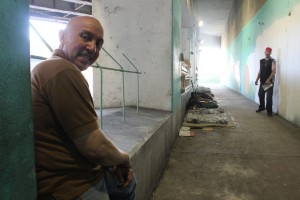By Darryl Holliday
AVONDALE — Construction is underway on concrete barriers designed to make it harder for the homeless to camp out under a Northwest Side overpass, a change that some suspect will only move the transients elsewhere.

The 5½-foot tall concrete fillers are being placed between support beams under the Kennedy Expy. at the Belmont/Kedzie underpass in a city and state effort to address safety and security complaints. The concrete pieces are sloped at the top to prevent the homeless from sleeping between the support beams.
The underpass is well-known as a homeless encampment going back nearly a decade, according to the Avondale Neighborhood Association.
And while the low-lit sidewalk under the expressway can be dangerous, the group questioned whether removing the makeshift bunks will solve the problem of the homeless in the neighborhood.
Emily Taylor, association president, said, “Our perspective is that the people living under there should be seen as our neighbors.”
She did acknowledge that “if you are trying to walk that sidewalk at night it can be scary because you don’t know who’s under there” but added, “The idea of putting up these blockades is that you’re just shifting the problem and not solving it.”
Ald. Rey Colon (35th) said he had met with a variety of organizations, including the city and state transportation departments, to figure out a way to create “a less comfortable sleeping arrangement” at the site.
No one wants to shuffle the encampment to a new location without resources, Colon said, but having them take advantage of existing services for the homeless has been difficult.
“For the most part they often return and resume the encampment,” Colon said.
“People are afraid to walk through there with everyone laying around,” he said, noting that he recently used part of his discretionary money to improve lighting and anti-pigeon efforts under the overpass.
“I’m not trying to displace people or put people in a bad predicament so I sympathize,” Colon said. “The issue is that’s not really an acceptable place for that encampment to be.”

A set of several 5½ foot concrete fillers with pitched edges are being placed under the Kennedy expressway at the Belmont/Kedzie underpass in a Chicago Department of Transportation and Illinois Department of Transportation in an effort to counter safety and security complaints. View Full Caption
Several homeless men at the site Wednesday said there has been trouble at the camp over the years but, for them, it is a reliable, relatively safe, place. Up to 12 people camp there each night, said Lazaro Alcazar, 56, who has lived in the underpass for two years.
“It’s not bad people here, just people who don’t have nothing to live on,” he said, leaning on one of the unfinished new barrricades.
Alcazar, who migrated to Chicago from Cuba when he was 11, said he’s seen violence over the last two years at the Belmont encampment, directed at him at and other homeless men. But he said “the community” of longtime campers tries to make sure new transient men and woman don’t cause trouble under the bridge.
“I put a stop to it when they don’t appreciate being here as a community,” Alcazar said. “We try to respect humans, as we are humans.”
According to Rene Heybach, director of The Law Project of the Chicago Coalition for the Homeless, the city has “done this before and they’ve done it in a number of places in the city.” The Kennedy underpass along California Avenue and Diversey Avenue includes fences to keep the homeless away from flat surfaces.
“I think the real question is what is the city doing in terms of offering housing to people,” she said. “Most of the street people we know want to be housed, they don’t want to live under underpasses.”
Alcazar agreed outside his purple Crown Victoria — he said he wants an apartment of his own. The homeless man said he receives Social Security each month, but his payments inevitably go toward his car and phone bill.
“You’ve got very kind people under this bridge like me, who have something to give the world, but they won’t let us,” he said. “I don’t know what’s going to happen to them, they’ll sleep on the floor here or something bad could happen.”
Meanwhile, another looming issue with the construction appears to be the height of the new cement platforms — at around 5-feet high, the barriers create a tunnel-like effect which some say makes it potentially dangerous for pedestrians.
Pedestrians cannot be seen from the street and the walkers cannot escape into the road if they needed to, a situation that Colon said “was not the intent” when he approached the city and state last year.
Jae Miller, a spokeswoman for the Illinois Department of Transportation, said the project is being handled jointly by the state and the Chicago Department of Transportation.
